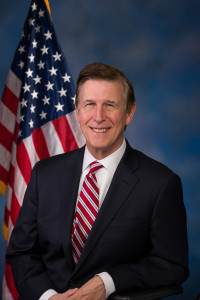Sequestration, 2016 spending deals remain far off, creating deeper budgetary holes for DoD
Former Defense Department Comptroller Bob Hale wants Congress to learn from the past five years of budgetary turmoil. Congress has about 10 work days when it ge...
“If you find yourself in a hole, you should first stop digging.”
That’s the message former Defense Department Comptroller Bob Hale is using to plead with Congress and the Obama administration, to find an end to five years of “budgetary turmoil.”
But Rep. Don Beyer (D-Va.) said he doesn’t have a lot of hope for a fiscal 2016 budget deal.
“We don’t seem to have learned anything from it, because if you ask me about what’s coming, I don’t see us getting a budget by Sept. 30,” Beyer said during a Sept. 2 discussion at the Brookings Institution in Washington. “Most people on the Hill anticipate something like the ‘cromnibus‘ of last December happening again this December just before we adjourn before the holidays.”
When Congress returns from recess on Sept 8, it will have has about 10 work days before the fiscal year ends.
The question of “what’s next?” is one that Hale, now a fellow at Booz Allen Hamilton, and Beyer discussed at length after recalling the unintended impacts of continuing resolutions, sequestration and a government shutdown.
“There’s always darkness just before the dawn,” Hale said. “We’ve seen two of these deals in the last five years. I think if you’ve gone back to the times before the American Taxpayer Relief Act and the Bipartisan Budget Act, you would have heard many of the same [things]. Oh, we can’t do it, we can’t do it. I think we can. I hope we do. But I’m not as confident as I was that it’s going to happen.”
He said Congress needs a budget deal similar to the Bipartisan Budget Act of 2013, which would cover fiscal years 2016 and 2017. A two-year deal means Congress could largely avoid a similar conversation next year in the middle of a presidential election.
Hale also argued for raising spending caps for both defense and non-defense agencies.
“There are some very important activities in non-defense, some of which are critical to national security and State Department and Homeland Security and others. They too need some added funding, there may have to be offsets,” he said, in a recent interview on In Depth with Francis Rose.
The worst-case scenario, Hale said, is another continuing resolution with no special authorities to move and reprogram funding for new weapons systems, environmental projects or military construction.
“It’s just a bad way to run a railroad, Hale said. “DoD can hold its financial breath for a couple of months under a clean, classic CR. But if you extend that to six months and especially if you thought of extending that to a year, serious problems would result. It would be very ineffective. We’re not going to stop defending the nation, but we will do it less effectively, it will harm DoD’s mission and we’ll be right back in the situation we’ve been in for the last five years.”
Budget disruptions and wasted time
The Defense Department is familiar already with the impacts of five years of budgetary turmoil.
DoD had to deal with $37 billion in cuts under sequestration in 2013 and lost about 30 percent of its daily operating budget, Hale wrote in a paper for Brookings. During the same year, the government shut down for 16 days, furloughing civilian Defense employees for four days before Congress called them back to work.

Between 2009 and 2014, the department planned for a government shutdown five times, Hale said. DoD relied on continuing resolutions twice for at least six months during that same five-year period, when it often appealed to Congress to reprogram funds from one account to another to maintain readiness and training, he said.
Hale served as the Pentagon’s comptroller from 2010 to 2014. He said he and his staff prepared two budgets for 2013 — one at funding levels DoD thought was appropriate and another that met lower spending cap levels.
“All the military services and agencies had to revise their FY 2013 budget plans and get new ones approved, a time-consuming process that usually takes a year, but had to be done in about a month,” Hale wrote. “Service and agency leaders spent countless hours managing efforts to accommodate the legally binding sequester cuts.”
Mission readiness, depleted training and morale
Other impacts from budgetary turmoil are harder to quantify.
Hale described a military that “wasn’t as good as it could have been” in 2013, in part, because the armed services cut training exercises. The Navy and Air Force canceled joint exercises with other countries during the sequester, he said, and the Army only sent half of its brigade combat teams to training centers in April 2013.
But he described low morale as the biggest “wound” still left open after the 2013 sequester, especially for civilian employees at DoD.
“They were clearly frustrated,” he said on In Depth. “But they did the high priority jobs when we allowed them to work, and I think most of them got done. But I know talking to some of them and talking to their managers, that some of them at least felt like they were pawns in a chess match.”

Beyer was an ambassador to Switzerland during the 2013 government shutdown. While he served overseas, he said he heard from foreign service members and civilian and military personnel who felt unappreciated and neglected — long before the shutdown.
“The primary responsibility of the leader is to set the culture, in which everyone can thrive,” he said. “[It] means banishing fear, people will be motivated, working together, feeling very valued and respected. Virtually every leader praises too little, and we’ve just had the opposite of the bell-shaped curve with our federal employees, which is just a terrible way to run a government.”
But the biggest step Congress and the Obama administration can take, Beyer and Hale said, is to come to a consensus about Defense for more than one year in advance. A quick fix for 2016 won’t solve many of the existing DoD problems.
“We don’t know what we’re planning for,” Hale said. “You always have some uncertainty about how your budget is. But the uncertainty now is quite broad.”
Copyright © 2024 Federal News Network. All rights reserved. This website is not intended for users located within the European Economic Area.
Nicole Ogrysko is a reporter for Federal News Network focusing on the federal workforce and federal pay and benefits.
Follow @nogryskoWFED



